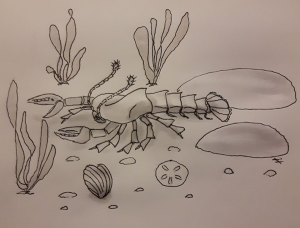Watol-Kiap
From World of Entorais Wiki
Jump to navigationJump to searchAbout
- Common Names
- Watol-Kiap - Creek Scooters (Tabras)
- Classification
- Arthropod
- These freshwater arthropods are found in the rivers and streams of Tabras and are considered a local delicacy by poorer folk. A common nick-name for them is "Creek Scooters" given for their predator evasion method of suddenly swimming backward using their tails and oar-like legs.
Description
- Size
- < 0.25 kg (< 1/2 pound), < 20 cm ( 5-6 inches)
- Appearance
- Long bodied with a flexible jointed tail terminating in a fan of flat scales, four pairs of walking legs and a pair of fore limbs ending in large pincers. Watol-Kiap have a pair of long antennae which rise above their bodies and detect changes in the water around them.
- Sexual Dimorphism
- males have a more distinct dorsal ridge on the main body behind their head.
- Variance
Ecology
- Habitat
- Found in freshwater rivers, lakes, and smaller tributaries in temperate to sub-arctic latitudes.
- Diet
- Watol-Kiap eat a variety of algae, river plants, small aquatic animals, and other organic detritus that is found on the lake and river bottoms.
Behaviour
- Social Grouping
- Solitary.
- Temperament
- Watol-Kiap are generally skittish around creatures larger than themselves, but will take a defensive position if they can back themselves into a sufficiently sized cover.
- Intelligence
- Negligible
- Reproduction
- Two sexes. Females will carry a clutch of eggs tucked under their tails while brooding, and the newly hatched fry may cling to their parent for a few weeks before venturing off on their own.
Notable Sub-Species
- There are a few different species of Watol-Kiap generally varied with Latitude or average water temperatures, with distinct morphological features.
Domestication
- General
- In some more established settlements they are effectively farmed by providing suitable river or lake habitat to support larger populations, but no direct domestication has been achieved.
- Resources
- Source of meat
